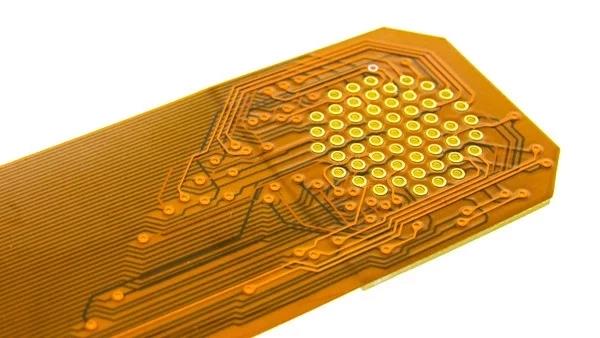Powerful Protection from Payment to Delivery
Secure and Reliable Payment
Money Back Guarantee
Shipping and Delivery
After-Sales Service
Guidance on Selecting Five Key Materials for Flexible Circuit Boards
With the rapid advancement of science and technology, electronic products are constantly evolving. Consequently, electronic assembly technology is also encountering various challenges. In response to the progress in electronic technology, individuals are striving to make groundbreaking advancements in electronic assembly techniques.
In this context, a remarkable invention has emerged: the flexible circuit board. Constructed using a thin and flexible polymer film, this innovative board enables the seamless application of surface mounting technology while maintaining the ability to bend without compromising the normal circuit operation.
1 Brief Introduction
Today, flexible electronics are predominantly manufactured using Surface Mount Technology (SMT), resulting in thin and delicate components with insulation thickness of less than 25 μm. These flexible electronics can be bent and rolled into cylindrical shapes, effectively utilizing three-dimensional space. This breakthrough in design allows for the optimization of volume and significantly enhances the effective density of conductors used per unit area, leading to high-density assemblies.
In recent years, flexible circuit technology has found applications in various fields, including radio communication, computers, and automotive electronic equipment. Unlike in the past, where flexible circuits were primarily used as alternatives to rigid cables, they are now replacing rigid circuits and printed circuit boards (PCBs) in scenarios that require thin or three-dimensional circuits. This integration of flexible circuit technology into rigid circuit boards has greatly expanded the use of flexible circuit boards.
Flexible circuit boards serve four main functions: lead lines, printed circuits, connectors, and integration of functions. These functions find applications in computer systems, computer peripheral devices, consumer electronics, automobiles, and other areas. The selection of materials for flexible circuit boards should be carefully considered based on the specific application requirements. The following are some guidelines for the five main materials used in flexible circuit boards.

2 Five Main Materials for Flexible Circuit Board
2.1 Insulating Film
The insulating film serves as the insulation carrier of the circuit board and forms the basic layer of the circuit. When selecting the flexible dielectric film, it is important to consider the heat resistance, overlay, thickness, mechanical properties, and electrical properties of the material.
The most common materials for insulation film in the market are polyimide and polyester. Approximately 80% of flexible circuit manufacturers in the United States use polyimide film, while about 20% use polyester film. Polyimide material is preferred due to its nonflammable nature, stable geometry, high tear resistance, and ability to withstand high temperatures during welding.
2.2 Bonding Sheet
The bonding sheet consists of two insulating films coated with adhesive. It is used to bond the film to the foil and the film to the film in the flexible circuit. The bonding sheet provides mechanical support, eliminates stress during the insertion of components and connectors, and offers protection and electrical insulation. Different types of adhesive sheets can be used for different film substrates. For example, polyester bonding sheets and polyimide bonding sheets have different properties. Polyimide substrates may have epoxy resin or acrylic acid.
2.3 Copper Foil
Copper foil is a conductor layer that is coated on the insulating substrate and selectively etched to form a conductive line. The most common types of copper foil used are rolled copper foil and electrolytic copper foil. Rolled copper foil has better ductility and bending resistance compared to electrolytic copper foil.
The elongation of rolled copper foil ranges from 20% to 45%, while electrolytic copper foil has an elongation of 4% to 40%. The commonly used thickness of copper foil is 35μm (1oz), but other options such as 18μm (0.5oz), 70μm (2oz), or even 105μm (3oz) are available depending on the application. If the goal is to replace wires and connectors while reducing manufacturing time and cost, electrolytic copper foil is the best choice. The increased weight of copper in electrolytic copper foil helps level the load capacity of the current, resulting in the appropriate width of the copper sheet.
2.4 Overburden
The brand Novaclad, created by Sheldahl, utilizes vacuum metal spraying technology, which is patented. This technology involves applying a thin layer of pure copper to the surface of a polyimide film, followed by electroplating to achieve a specific thickness, forming the Novaclad substrate.
The Novaclad base material is used in Novaflex, a flexible circuit without adhesive. After all the circuits have been created, a layer of Novaflex insulation is applied. Novaflex is designed to withstand harsh conditions and the absence of adhesive provides better flexibility, chemical resistance, high-temperature properties, and maximum heat dissipation properties.
2.5 Reinforcement Plate
The reinforcement plate is used to provide additional support and strengthen specific areas of the flexible circuit board. It facilitates connection, fixation, and other functions of the PCB. Commonly used materials for reinforcement plates include polyester, polyimide sheet, epoxy fiberglass cloth plate, phenolic-aldehyde paper board, steel plate, and aluminum plate. The choice of reinforcement board material depends on specific needs and requirements.

3 FAQ
1. What is a flexible circuit board?
A flexible circuit board, also known as a flex circuit board or flexible printed circuit (FPC), is a type of printed circuit board that is made of a flexible substrate. It consists of several printed circuits and components that are positioned on the flexible substrate, allowing it to conform to small spaces and contoured shapes.
2. What is a flex circuit used for?
Flex circuits are commonly used as connectors in applications where flexibility, space savings, or production constraints limit the use of rigid circuit boards or hand wiring. They are often found in computer keyboards, where they are used for the switch matrix. Additionally, flex circuits are used in automobiles, consumer electronics, medical systems and devices, motion systems, GPS systems, and aerospace and avionics systems.
3. What are flexible circuit boards made of?
Flexible circuit boards are made of thin, lightweight materials that can withstand bending and flexing. They typically consist of conductive strips of metal, usually copper, that are encapsulated with an insulating dielectric material. The dielectric material is commonly made of polyimide or a solder mask, which provides electrical insulation and protection for the circuit.
4. When was the first flex printed circuit made?
The first flexible printed circuit was developed during World War II. Since then, flex circuits and flexible printed circuit boards have seen exponential growth and proliferation in various industries.
5. What are the advantages and disadvantages of flexible circuit boards?
Advantages of flexible circuit boards include high assembly density, which can eliminate the need for redundant cables, as well as good bendability, high flexibility, small size, simple structure, and convenient installation. However, there are also disadvantages to consider, such as high initial cost, difficulty in changing and repairing, size limitations, and susceptibility to damage if improperly handled.
6. What is the temperature resistance of FPC flexible circuit boards?
FPC flexible circuit boards can withstand high temperatures up to 280 degrees Celsius for approximately one hour. However, for normal use, it is recommended to operate within a temperature range of -20 to 80 degrees Celsius.
7. Why are PCB hard printed circuit boards still not eliminated despite the presence of flexible circuit boards?
PCB hard printed circuit boards are still used for certain applications. For example, if plug-in components are required, rigid boards are necessary. Additionally, rigid boards are preferred for PCBs with stress requirements. The cost of flexible boards is currently higher than that of rigid boards, and the straight-through rate of rigid boards is higher as well.
8. What are the classifications of flexible circuit boards?
Flexible circuit boards can be classified into two types based on the combination of base material and copper foil: flexible boards with glue and flexible boards without glue. Glueless flexible boards have a higher price but offer better flexibility, bonding force between the copper foil and substrate, and pad flatness compared to glued flexible boards.
Recent Posts








Company
About UsContact UsTerms & ConditionsPrivacy StatementPayment,Shipping & InvoiceRefund & Return PolicyWarranty PolicyFrequently asked questionHolidays for Chinese Mid-Autumn Festival and National Day in 2023


















